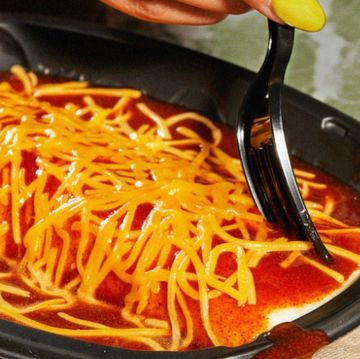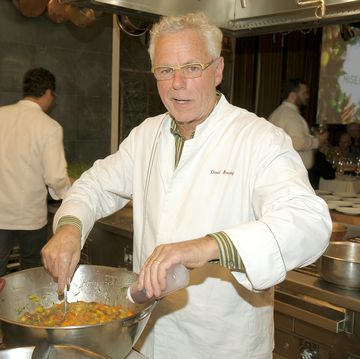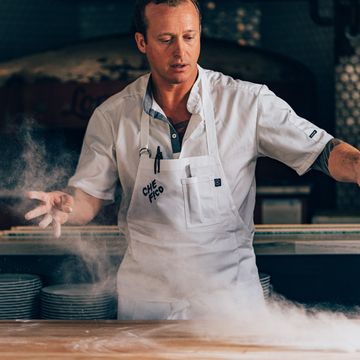American gastronomy is at all-time high. Our chefs are the most creative they've ever been. The number of good ones has increased tenfold. Their technique is masterful; their skill level sky-high. They use better ingredients than ever did before; and they take more care than ever before. There's only one problem, as I see it.
Nobody is actually cooking.
Now, this is not a universal condemnation; I don't wish to bury our chefs in mindless blanket criticism, like a chicken-fried steak under a pool of gravy. That would be dismissive. Even worse, it would be dumb. But at the same time, it's impossible for me not to notice that almost all of the dishes I find myself eating these days are not so much created as composed. Is that the same thing as cooking? You tell me.
Here are four dishes from four celebrated restaurants. All represent trends or schools credited, by nerds like me, with having their own discrete identities. One is lardcore; another is high modernist; another is greenmarket/locavore; and the last one, coming straight outta Copenhagen, as it were, is New Norwegian. Here are the four dishes:
• Oyster, lovage, garlic.
• Lamb belly, braised lettuce, mushroom hay, yogurt curds.
• Golden tilefish, sweet potato, radicchio.
• Roasted redfish, whole roasted celery root, compressed Granny Smith apples, bok choi, Brewster oats, dill
The restaurants are, in order: Aska (Brooklyn), Ink (L.A.), Barley Swine (Austin), and Husk (Nashville). But you would never know they came from different establishments based on the descriptions (somewhat understandable, as contemporary menu language is so cryptic and laconic that it's barely more than a list of ingredients). More relevant, they all pretty much look the same, too. And the reason they look the same is that their creators all pretty much think the same. A protein is pared down with the loving skill of a sushi master (and frequently with the knife of one, too); it is then prepared in some diabolically clever way, and put into the center of a plate. Some vegetable, prepared with equal virtuosity, is plated with like meticulousness, on the same plate. Finally, some third ingredient, and possibly a fourth, is added on top, with or without tweezers. These items were either cooked or cured or grown separately, and they are put on the plate separately, and when I eat them, I eat them separately, unless I manage to spear two or three of them on the same fork tine. Sure, one dish might have a fermented carrot, and other locally milled grits; otherwise they differ no more than Hef's girlfriends.
That's not cooking; it's assembling. Cooking, in the most meaningful sense, transforms foods into some other, more complex food. A coq au vin has carrots, and it has bacon, and it has mushrooms, and it has chicken, but the dish itself has a separate identity that is greater than its parts. The same goes for pot-au-feu and Brunswick stew and feijoada and mofongo and cassoulet. Somebody might point out that those are all long-braised winter dishes, but guess what? This is winter. And if you go out tonight to your favorite new restaurant for some "seasonal" cooking, your main course will consist of three dominoes of duck with a little dollop of emulsion, some lovage, and five sea beans next to them.
I know that people like me have been complaining about skimpy portions and newfangled methods since the advent of nouvelle cuisine fifty years ago. But the nouvelle cuisine at least had sauces.
I often wonder to myself why I like Italian food so much. Why am I happier with a bowl of spaghetti than I am with a duo of squab with glazed parsley root and three and a half grams of kimchi? It's not because I have the palate of a child. It's because pasta is one of the last bastions of melded flavors. All the elements — whether sepia or marrow or white truffles or black truffles or bagna càuda — are caught up in a whirl of flavor, a single unifying force that twines its way even around each tine, and delivers its cumulative power in a single forkful.
Is that really too much to ask?
I don't single out anyone here. Every chef does it everywhere, at every service, more or less. But the universal abandonment of actual cooking has had the result of breaking down the walls between one kind of restaurant and the next; gastrocrats can go pretty much anywhere and eat pretty much the same thing. This was also the case a century ago, when rich people ate the same truffles and foie gras in the same hotel dining rooms. But is that really what we want to go back to? I understand that it's easier to fire three or four precious elements, each in their own pan, a la minute. I understand that today's high-end diner seeks painterly beauty and the integrity of discrete ingredients, and doesn't want a bowl of stew set in front of him. I just don't give a shit. If the chef's only function was to supply diners with exactly what they were used to eating, and exactly what they thought they liked, they would just serve them bacon and bone marrow on everything. Oh, wait — that is what chefs do.
If you are a young cook coming up, there is a major challenge facing you. This is a pivot point for American cuisine (whether Americans know it or not). Somebody needs to reinvent the art of cooking. I don't know who is going to do it; maybe nobody wil. A few chefs seem to be up to the task. I want to experience Corey Lee's work at Benu in San Francisco; it looks like more than just the sum of its parts. John Besh's cooking, at its best, draws on Louisiana traditions that require him to deliver a finished composition — dirty rice, oyster pan roasts, whole stewed rabbits, file gumbo, etouffe. I was at a Christmas party last month and Alex Lee, the legendary former chef de cuisine at Daniel, showed up with a Spanish langoustine and dirty-rice paella, every grain enriched with old-school crustacean butter, and the whole thing ringed with big, primordial-looking shrimp heads jammed full of andouille forcemeat. If that dish had been served in a contemporary tasting-menu restaurant, it would have consisted of three shrimps, a dollop of "dirty rice" in quotation marks, and a slice of andouille as perfectly rectangular as a township in Nebraska. Which one would you rather eat? Which one is better? I will tell you: Alex Lee's is better.
I'm not here to correct the practice of our chefs. I have never worked in a restaurant, my tastes are primitive, and I doubt I will ever know as much about food as an average high-end line cook does by the age of twenty-five. I'm not here to provide a solution, and I'm not here to tell anyone how to cook. I don't know how to cook. I only know how to eat. I'm asking our chefs to cook, really cook, and if they can't do it, I'm hoping someone else can. Because I really miss it.












